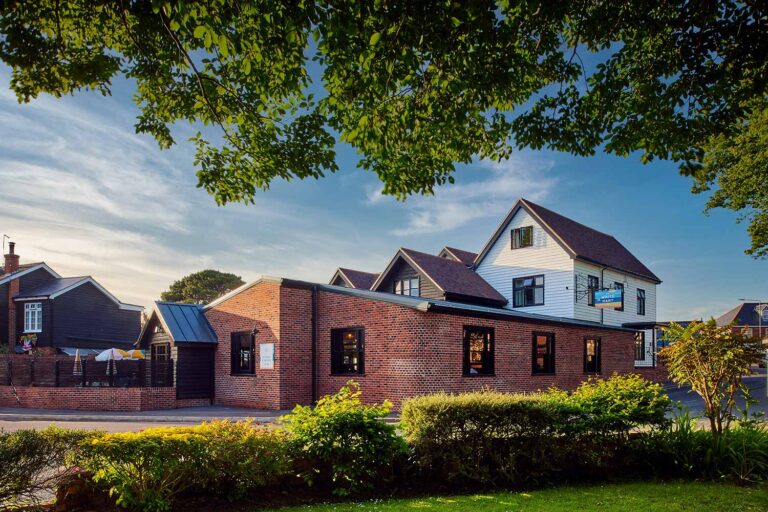Winning an award for their “sympathetic and dedicated” renovation, the two idyllic, 16th-century…
Up Paglesham Creek

A stroll along the sea wall from Paglesham Eastend to Paglesham Churchend, in the footsteps of smugglers and oyster fishermen.
6.25 miles (10.1kms)
About the walk
Paglesham, just a few miles from Southend-on-Sea, is bordered to the north by the River Crouch and to the south by the River Roach. Its origins go back to Saxon times, and its population survived mainly by rearing sheep that grazed on the flat marshlands. But its remote position on Essex’s east coast, and its proximity to waterways, attracted smugglers who would sail up the river bringing in their ill-gotten gains to pass on at a profit to anyone who was happy to make some easy money.
Brazen Blyth
Smuggling was such big business that at one time the entire population of Paglesham was involved in one way or another. In the 18th century one famous resident, William Blyth – also known as ‘Hard-Apple’ Blyth – was considered one of the most notorious smugglers Paglesham ever produced. He started out as the village grocer, progressed to churchwarden, and was reputed to have torn up church records to use as wrapping for his butter and bacon. Brazen Blyth would not only evade Customs officials, but his party piece was spending evenings at The Punch Bowl Inn, drinking whole kegs of brandy and crunching wine glasses. This unusual diet and lifestyle clearly did him no harm – he died in 1830, aged 74.
Wife and oyster farming
‘Wife-farming’ seems to have been another popular pastime. Daniel Defoe, in his travels around Paglesham, noted that some men boasted that they had 15 or more wives. Stories circulated that women who couldn’t stand the rigorous lifestyle and bad weather here either died from the cold or abandoned their husbands for a more comfortable existence in the uplands, from where they originally came. The men would simply choose a replacement. When the villagers weren’t smuggling or ‘wife-farming’ they were engaged in oyster farming, a lucrative business which peaked in the mid-19th century. Oysters were considered common food for Londoners, who couldn’t get enough of them, and the demand provided the people of Paglesham with plenty of work. Scores of fishermen would sail out along the estuaries of the Crouch and Roach and return to have their oysters processed by one of the big companies, such as the Roach River Company, now long gone.
On this walk you will see sheep grazing along the grassy sea wall and marshland, just as they have done for centuries, but you’ll have to look hard for smugglers in the creeks and estuaries. Oysters are still farmed locally, and an annual oyster festival brings a flurry of enthusiastic foodies to the pubs.
Walk directions
Walk to the left of The Plough and Sail pub along a drivable track, and after 100yds (91m) follow the fingerpost straight ahead to the left of the house called Cobblers Row. Maintain direction along a good field-edge path, with arable fields either side, until you reach a red brick wall on your left. Go along the lawn of Well House and follow the tarmac lane as it curves left.
At the corrugated barn of East Hall, follow the Roach Valley waymarker, right and then left, and at the public footpath sign turn left and maintain direction along the grassy field-edge. Walk by paddock fencing, with Church Hall on your right and the pond on your left, to St Peter's Church at Paglesham Churchend.
Keeping the church on your right, continue along Churchend High Street to The Punch Bowl Inn. Maintain direction for 50yds (46m), then take the concrete path to your right soon after the two houses. This passes to the left of a small pumping station and then becomes a grassy field-edge path, running parallel with a waterway on your left.
Take a short clamber up the grassy embankment and, leaving the Roach Valley Way, turn right onto the sea wall of Paglesham Creek. There is a lovely view back towards the church from this point. Keep to the path as it meanders by Paglesham Creek, which widens as you approach the River Roach. To your left the salt marshes stretch towards the River Crouch, where you have views of the marinas of Burnham-on-Crouch and the warehouses and timber yards of Wallasea Island. Much of the landward side of the embankment is given over to sheep grazing, which makes this walk somewhat difficult for larger dogs, as enclosures are often divided by wooden stiles and low-voltage electric fencing. After three stiles go through a kissing gate and bear left.
As the path bears right, with the river on your left, maintain direction past oyster beds until you reach the boatyard. Go down the steps from the sea wall and pick your way through boats and machinery to the gate. Pass beside the gate and follow the unmade track to pass a row of cottages on your left, followed by Cobblers Row and the fingerpost on your right that were on the route for the outward journey. Turn left and return to The Plough and Sail pub at Paglesham Eastend.
Additional information
Grassy sea wall, field-edge, unmade tracks
River estuary, salt marsh, mudflats, grazing and arable farmland
Lead required along sea wall, and where sheep graze
OS Explorer 176 Blackwater Estuary, Maldon
Informal street parking at Paglesham Eastend beside The Plough and Sail inn
None on route
WALKING IN SAFETY
Read our tips to look after yourself and the environment when following this walk.
Find out more
Also in the area
About the area
Discover Essex
Essex is full of pleasant surprises. It has the largest coastline of any county in England, with its fair share of castles, royal connections and scenic valleys. Take Colchester, for example, which was built by the Romans and is Britain’s oldest recorded town. Its castle contains the country’s largest Norman keep and yet, a stone’s throw from here, East Anglia’s newest arts centre promises to put Colchester firmly on the map as Essex’s capital of culture.
Tidal estuaries are plentiful and their mudflats offer migrating birds a winter feeding place. Essex was known as the land of the East Saxons and for centuries people from all over Europe settled here, each wave leaving its own distinctive cultural and social mark on the landscape. Walking a little off the beaten track will lead you to the rural retreats of deepest Essex, while all over the county there are ancient monuments to explore:
- the great Waltham Abbey
- Greensted, thought to be the oldest wooden church in the world
- the delightful village of Pleshey has one of the finest examples of a former motte-and-bailey castle
- Hedingham Castle, magnificently preserved and dating from the 11th century.
Nearby stays
Restaurants and Pubs
Nearby experiences
Recommended things to do
Why choose Rated Trips?
Your trusted guide to rated places across the UK
The best coverage
Discover more than 15,000 professionally rated places to stay, eat and visit from across the UK and Ireland.
Quality assured
Choose a place to stay safe in the knowledge that it has been expertly assessed by trained assessors.
Plan your next trip
Search by location or the type of place you're visiting to find your next ideal holiday experience.
Travel inspiration
Read our articles, city guides and recommended things to do for inspiration. We're here to help you explore the UK.















